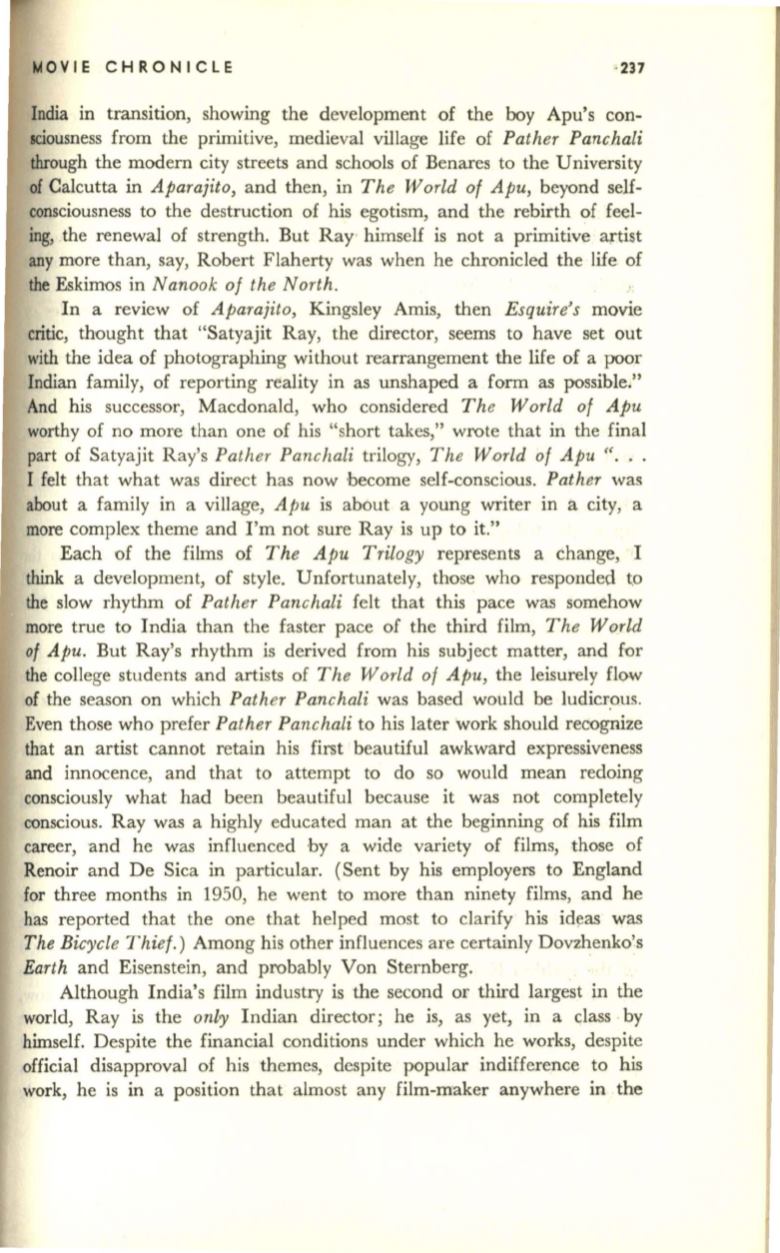
t.COVIE CHRONICLE
· 237
India in transition, showing the development of the boy Apu's con–
lciousness from the primitive, medieval village life of
Pather Panc.hali
through the modem city streets and schools of Benares to the University
of
Calcutta in
Aparajito,
and then, in
The World of Apu,
beyond self–
consciousness to the destruction of his egotism, and the rebirth of feel–
ing,
the renewal of strength. But Ray himself is not a primitive artist
any
more than, say, Robert Flaherty was when he chronicled the life of
the Eskimos in
Nanook of the North.
In a review of
Aparajito,
Kingsley Amis, then
Esquire's
movie
critic, thought that "Satyajit Ray, the director, seems to have set out
with
the idea of photographing without rearrangement the life of a poor
Indian family, of reporting reality in as unshaped a form as possible."
And his successor, Macdonald, who considered
The World of Apu
worthy of no more than one of his "short takes," wrote that in the final
part of Satyajit Ray's
Pather Panchali
trilogy,
The World of Apu
" ...
I felt that what was direct has now become self-conscious.
Pather
was
about a family in a village,
Apu
is about a young writer in a city, a
more complex theme and I'm not sure Ray is up to it."
Each of the films of
The Apu Trilogy
represents a change, I
think
a development, of style. Unfortunately, those who responded t.o
the slow rhythm of
Pather Panchali
felt that this pace was somehow
more true to India than the faster pace of the third film,
The World
of Apu.
But Ray's rhythm is derived from his subject matter, and for
the college students and artists of
The Worid of A pu,
the leisurely flow
of the season on which
Pather Panchali
was based would be ludicrous.
Even those who prefer
Pather Panchali
to his later work should recognize
that an artist cannot retain his first beautiful awkward expressiveness
and innocence, and that to attempt to do so would mean redoing
consciously what had been beautiful because it was not completely
conscious. Ray was a highly educated man at the beginning of his film
career, and he was influenced by a wide variety of films, those of
Renoir and De Sica in particular. (Sent by his employers to England
for three months in 1950, he went
to
more than ninety films, and he
has reported that the one that helped most to clarify his id!!as was
The Bicycle Thief.)
Among his other influences are certainly Dovzhenko's
Earth
and Eisenstein, and probably Von Sternberg.
Although India's film industry is the second or third largest in the
world, Ray is the
only
Indian director; he is, as yet, in a class by
himself. Despite the financial conditions under which he works, despite
official disapproval of his themes, despite popular indifference to his
work, he is in a position that almost any film-maker anywhere in the


